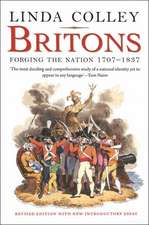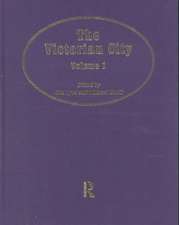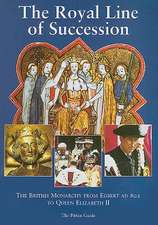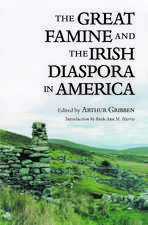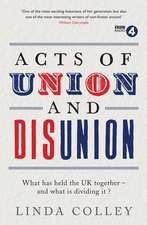Captives: Britain, Empire, and the World, 1600-1850
Autor Linda Colleyen Limba Engleză Paperback – 31 dec 2003
Here are harrowing, sometimes poignant stories by soldiers and sailors and their womenfolk, by traders and con men and by white as well as black slaves. By exploring these forgotten captives – and their captors – Colley reveals how Britain’s emerging empire was often tentative and subject to profound insecurities and limitations. She evokes how British empire was experienced by the mass of poor whites who created it. She shows how imperial racism coexisted with cross-cultural collaborations, and how the gulf between Protestantism and Islam, which some have viewed as central to this empire, was often smaller than expected. Brilliantly written and richly illustrated, Captives is an invitation to think again about a piece of history too often viewed in the same old way. It is also a powerful contribution to current debates about the meanings, persistence, and drawbacks of empire.
| Toate formatele și edițiile | Preț | Express |
|---|---|---|
| Paperback (2) | 121.22 lei 3-5 săpt. | +19.10 lei 7-13 zile |
| Vintage Publishing – 4 sep 2003 | 121.22 lei 3-5 săpt. | +19.10 lei 7-13 zile |
| Anchor Books – 31 dec 2003 | 139.17 lei 3-5 săpt. |
Preț: 139.17 lei
Nou
Puncte Express: 209
Preț estimativ în valută:
26.65€ • 27.46$ • 22.36£
26.65€ • 27.46$ • 22.36£
Carte disponibilă
Livrare economică 01-15 februarie
Preluare comenzi: 021 569.72.76
Specificații
ISBN-13: 9780385721462
ISBN-10: 0385721463
Pagini: 464
Ilustrații: 74 ILLUSTRATIONS IN TEXT
Dimensiuni: 130 x 203 x 25 mm
Greutate: 0.41 kg
Editura: Anchor Books
ISBN-10: 0385721463
Pagini: 464
Ilustrații: 74 ILLUSTRATIONS IN TEXT
Dimensiuni: 130 x 203 x 25 mm
Greutate: 0.41 kg
Editura: Anchor Books
Notă biografică
Born in Britain, Linda Colley has taught and written on history and current events on both sides of the Atlantic. Previously at Cambridge, Yale, and the London School of Economics, she is now Shelby M.C. Davis 1958 Professor of History at Princeton University. Her previous books include In Defiance of Oligarchy: The Tory Party, 1714-1760, Namier, and Britons: Forging the Nation, 1707-1837, for which she won the Wolfson Prize.
Extras
Chapter 1
ONE
Tangier
Breakers
The strip of sea that brought them to the shores of their new prize and the entrance to the Mediterranean is famously volatile. Even today, crossing or passing through the straits of Gibraltar, the narrowest stretch of water between Europe and Africa, is a slow and turbulent business. However bright the sunshine at embarkation, strong winds and rain can move in swiftly, blotting out coastlines and turning the oil-flecked, ultramarine sea into a choppy slate grey. In bad weather, the trip churns the stomach and can be dangerous. Migrant workers from Morocco and Algeria, their belongings tied up in immaculate brown paper parcels, together with some hardier backpackers will still entrust themselves to the larger, older ferry boats, huddling below deck amidst the cigarette smoke and old coffee stains. But comfortable tourists looking forward to a sea excursion from Gibraltar to Tangier ('Your Day Out In Africa') cancel their bookings in droves, while the smaller, faster hydrofoils linking Tangier with Tarifa and Algeciras in Spain sometimes cease operating. As for amateur craft, they can vanish altogether. Hundreds of men and women still die on this eight-mile stretch of water every year.
It was the unpredictability of its offshore waters, the sudden, violent rainstorms, and the quirks of the landscape that most impressed the English occupation force when it first arrived in Tangier in 1662, yet these things did not make the soldiers, officials and families feel any more at home. The fact that, at a distance and shrouded in mist, the low mountains behind Tangier might almost have passed for those of North Wales, only accentuated the strangeness of the rest: the clarity of the Mediterranean sunlight, the expansive sands, the luminosity of the settlement's white and ochre-coloured buildings, fruits and vegetables most of them had never tasted before, roses that bloomed even in winter. Sir Hugh Cholmley, though, remained undistracted and was immediately busy, for his mission was to regulate the sea itself.
Cholmley was a Yorkshire landowner from a moderately royalist background, a highly intelligent and driven man whose idea of relaxation was pegging away at mathematical puzzles. He was also a gentlemanly capitalist of a kind, as concerned to invest in England's intermittently expanding empire overseas, as he was to diversify his income at home. He developed the alum mines on his family estates at Whitby, married off his daughter to a speculator in Indian diamonds, and, most of all, applied himself mind and muscle to Tangier. Charles II, King of England, Scotland and Ireland, had acquired the settlement along with other colonial booty in 1661, as part of the dowry of his sad, barren Portuguese bride, Catherine of Braganza. One year later, Cholmley signed a contract with the government to build a mole at Tangier at the rate of thirteen shillings for every cubic yard completed. As Cholmley noted down with typical thoroughness, the word 'mole' comes from the French and Latin for a great mass. The idea was to construct a substantial artificial outcrop or breakwater from Tangier's natural shoreline, lined with cannon and other defences, and thereby make the harbour deep enough for the Royal Navy's largest warships, and a safer, more congenial haven for what was expected to become an ever-growing share of the world's trade.
For Tangier was and is a special place. Its now dated reputation for transgressive sexualities and international intrigue masks its extraordinary strategic and geographical significance, but does at least acknowledge the city's role as a meeting-place for different cultures. Adjacent to the point where the continent of Africa comes nearest to Europe, it is bounded on the one side by the Atlantic, while commanding on the other the western entrance to the Mediterranean. So its attractions for its English occupiers were profound and plural. At one level, Tangier offered a base from which they could look to make further commercial and colonial advances into the North African interior. At another, it supplied them with a naval stronghold from which to monitor the fleets of richer and more powerful European rivals, Spain, and above all France. At yet another level, Tangier guarded the entrance of what one contemporary called 'the greatest thoroughfare of commerce in the world', by which he meant not the Atlantic Ocean, but the Mediterranean, at this stage still the most profitable arena by far for English imports and exports. Trade with southern Europe and the eastern Mediterranean seaboard, Turkey and the Levant, had been expanding since before 1600. England shipped its cloth here of course, as well as fresh and salted fish for the Catholic ports, and by the second half of the seventeenth century an ever-growing supply of colonial re-exports, pepper, tobacco, sugar, East Indian silks and calicos. In return, the English looked to the Mediterranean for imports of Levantine silks and dyestuff, for Turkish cotton and Spanish short wool, for Italian wine and Portuguese Madeira, for leather and fine horses from Morocco, and raisins, figs, oranges and olives to diversify the diet of the well-off. Tangier appeared an ideal base and mart for this rich and varied commerce, and one of the first things that London did after 1662 was proclaim it a free port.
On expansionist, strategic, and commercial grounds, then, Tangier seemed to the English an impeccably prudent acquisition that would in due course pay for itself many times over, 'a jewel', as Cholmley put it. Samuel Pepys, writing as a naval administrator and member of the council responsible for the new colony, rather than in his more familiar guise as a man-about-town, confided in his diary that Tangier was 'likely to be the most considerable place the King of England hath in the world'. Catherine of Braganza's other bonus, Bombay, struck him by contrast as no more than 'a poor little island', too distant ever likely to be made properly useful. In seventeenth-century sailing-ship time, Bombay was at least half a year from London; and even England's North American colonies were three months away. Tangier, though, offered proximity as well as seemingly limitless potential. A fast merchantman setting out from London could reach it in well under two weeks. Not surprisingly, then, in the early years of its occupation, the new colony was talked of in official circles 'at a mighty rate as the foundation of a new empire'. It would be easy, urged one supporter in the 1670s, for Charles II so to exploit Tangier as 'to command our northern world, and to give laws to Europe and Africa'.
Money was lavished on the colony on a scale appropriate to these ambitions. The Portuguese had allowed the place to decay, and major rebuilding began almost as soon as the 4000-strong occupation force arrived, many of the troops veterans of Oliver Cromwell's New Model Army. Long, fortified walls began to coil around the settlement 'one without another, as there are [skins] to an onion'. The Bohemian engraver turned English court artist, Wenceslaus Hollar, sketched some of them on an official visit in 1669, together with the newly named towers and fortresses they interlinked, Peterborough Tower, York Castle, Henrietta Fort, Charles Fort, James Fort. Intricate and precise, the last substantial works Hollar ever completed, these drawings suggest something of the scale of the English investment in Tangier, and their confidence at this stage in its permanence. The drawings convey something else as well. Hollar's panoramic views of the new fortifications are clearly designed to impress, yet at the same time he makes Tangier appear familiar and even domestic. A workman and his wife dressed in sombre English fashions trudge homewards arm in arm, their only protection an ambling dog. Carts trundle usefully along well-built roads. And the neatly tiled roofs of the houses inside the city's fortified walls cluster together as reassuringly as if they were located in Hollar's adopted London or his native Prague. Looking at these scenes, there is precious little to indicate that they are set on the northernmost shores of Africa.
Nor did Hollar's employer, Charles II, intend that there should be. Tangier's royal charter, issued in 1668, confined office-holding and voting in the colony to Christians and of course to men. The region's Muslim inhabitants, it insisted, were 'so barbarous and so poor and so continuously embroiled in civil wars, that no near prospect can be imagined to make them apprehended'. In the official mind, Tangier was projected as a substantial colony of settlement with an agenda from the start of expansion, commerce and anglicisation; and initially some roots were put down. By the 1670s, there were almost as many civilian settlers in Tangier as there were soldiers, including over 500 women and children. They lived in a city marked out now with English street names and with its own corporation. Every Sunday, Tangier's mayor, aldermen and common councilmen would put on specially designed scarlet and purple robes and process stickily to its Anglican church, where a pew lined with green velvet cushions awaited the colony's governor and his lady, and a carved and painted image of Charles II's coat of arms was prominently displayed. Through the leaded windows, the more inattentive worshippers could catch a glimpse of an ancient monument inscribed in Arabic still standing firmly in the new Anglican churchyard. But, if their eyes strayed in that direction, it was probably only for an instant, for after the service there were other pursuits to look forward to, especially if you were male. There was Tangier's new bowling-green, where the resident army officers played against the more affluent inhabitants, or the city's growing range of brothels or, for the chaste and studious, a visit to its library from which some unknown settler stole away with the single copy of John Milton's Paradise Lost. These colonisers, it seemed, were making themselves at home.
Never before in its history had the English state, as distinct from private investors and trading companies within it, devoted so much effort and thought, and above all so much money to a colonial enterprise outside Europe. The surviving accounts, which are incomplete, suggest that in the 1660s Tangier cost on average over £75,000 every year. Cutting down on its military garrison and establishing a civilian administration failed to reduce the drain on the Crown. Average annual expenditure on the colony between 1671 and 1681 rose to almost £87,500. Altogether, this North African episode appears to have sucked in close to two million pounds, a substantially greater sum, as Tangier's last governor, Lord Dartmouth, remarked, than Charles II spent on his other overseas outposts, or on all of his garrisons on home territory put together. Over a third of this money went on funding Sir Hugh Cholmley's stupendous mole.
Outwardly at least, the man behaved as though unrelenting energy and technical ingenuity were enough to transform and possess an alien landscape. He removed so many rocks from Tangier's beaches that its city walls began to subside. Undeterred, he blasted out a new quarry to the west of the settlement, and built a road to transport stone from there to the mole. When the garrison troops, who laboured on the project in their hundreds, still proved insufficient for the task, Cholmley imported skilled workmen from Yorkshire, building them a dormitory town that he named after his native Whitby. Nothing, it seemed, was to get in his way. An uncle summoned to Tangier to assist him sickened and died. His own wife had the temerity to fall pregnant. The family's maids were captured at sea by Barbary corsairs. Yet still Cholmley pressed on. By 1668, in defiance of atrocious weather and at a huge cost in money and lives, Cholmley's mole already extended some 380 yards from the North African shore. By the mid-1670s, it stretched 457 yards out to sea, was 110 feet in width, and rose eighteen foot out of the water. Twenty-six cannon guarded one side, while two batteries of 'great gunnes' protruded from the other.
This was by far the most ambitious engineering work ever carried out up to this point by Englishmen working outside Europe: and in this, as in other respects, Tangier's significance in imperial terms was much greater than itself. Its astonishing mole was the first of those ambitious constructions in stone, brick and iron - bridges, dockyards, railways, roads, dams and canals - which the British subsequently scattered over every part of their overseas empire, means to facilitate trade, transport and control, but also attempts to compensate for their own intrinsic smallness and sparsity of numbers by imposing on the landscape large, enduring monuments in their own technological image. In one draft of his memoirs, Cholmley even compared himself to Nebuchadnezzar, the Babylonian ruler of the Old Testament, who built a mole to subdue the inhabitants of Tyre. A more appropriate analogy, as it turned out, would have been King Canute, except that what was advancing against the English at Tangier was more than just the power of the sea.
Winter gales and fierce coastal currents breached the mole some thirty times during its construction, reducing Cholmley to bouts of despair that he was wasting his youth and energy on an 'endless feeding of the sea with stones'. Not until 1677 was his surveyor, Henry Sheeres, able to inform London that the project had finally been completed. Tangier's mole, all three million cubic foot and 170,000 tons of it, now stood firm in the water, crowed Sheeres unoriginally, 'like a rock'. Just seven years later, the rock shattered into rubble. Forced to evacuate Tangier in 1684, the English exercised the only power left to them and destroyed what they had previously built up at such cost. The intricate houses, the splendid forts, the ringed, defensive walls that Wenceslaus Hollar had found so sketchworthy, and finally Cholmley's engineering triumph, the great mole itself, were all detonated and demolished so as to avoid yielding them up to those Moroccan armies that had always been in wait and watching as the English focused on the dangerous, commerce-laden sea. On Charles II's orders, new-minted coins bearing his engraved image were buried deep in what was left of Tangier: 'which haply, many centuries hence when other memory of it shall be lost, may declare to succeeding ages that [this] place was once a member of the British empire'.
Now, alas, Tangier!
That cost so dear,
In money, lives, and fortunes . . .
Another sea, another view
It is a strange picture. Men in salt-stained, dust-encrusted uniforms scrambling over smoking ruins, feverishly digging small graves for samples of the king's coinage, as colonial ambition dwindles into the stuff of archaeology. But then the entire Tangier episode appears strange in the light of conventional and current narratives of empire, so much so, that it is usually left out of them altogether. Despite its drama and importance at the time, the unprecedented amounts of state money poured into it, and Cholmley's extraordinary, vanished marine masterwork, only one major book has ever been written about Tangier's rise and fall as seventeenth-century England's most elaborate and expensive extra-European colony. Even this was published before the First World War, and it is suggestive that the E.M.G. Routh whose carefully neutral initials grace the title page of Tangier: England's Lost Atlantic Outpost (1912) was a woman, someone who worked outside the then almost entirely male establishment of imperial historians. Routh's solitary and scrupulous investigations have had little impact. The most recent and authoritative survey of England's fledgling empire in the seventeenth century, compiled by a team of American and Irish as well as British scholars, glances at Tangier barely half a dozen times in well over 500 pages. As for Sir Hugh Cholmley, that strange, maniacal imperial projector and builder, his name has long since disappeared from the history books and is absent, too, from The Dictionary of National Biography. It is a powerful demonstration of just how effectively Britain's sporadic imperial disasters and retreats were expunged from the historical record and from national and even international memory.
ONE
Tangier
Breakers
The strip of sea that brought them to the shores of their new prize and the entrance to the Mediterranean is famously volatile. Even today, crossing or passing through the straits of Gibraltar, the narrowest stretch of water between Europe and Africa, is a slow and turbulent business. However bright the sunshine at embarkation, strong winds and rain can move in swiftly, blotting out coastlines and turning the oil-flecked, ultramarine sea into a choppy slate grey. In bad weather, the trip churns the stomach and can be dangerous. Migrant workers from Morocco and Algeria, their belongings tied up in immaculate brown paper parcels, together with some hardier backpackers will still entrust themselves to the larger, older ferry boats, huddling below deck amidst the cigarette smoke and old coffee stains. But comfortable tourists looking forward to a sea excursion from Gibraltar to Tangier ('Your Day Out In Africa') cancel their bookings in droves, while the smaller, faster hydrofoils linking Tangier with Tarifa and Algeciras in Spain sometimes cease operating. As for amateur craft, they can vanish altogether. Hundreds of men and women still die on this eight-mile stretch of water every year.
It was the unpredictability of its offshore waters, the sudden, violent rainstorms, and the quirks of the landscape that most impressed the English occupation force when it first arrived in Tangier in 1662, yet these things did not make the soldiers, officials and families feel any more at home. The fact that, at a distance and shrouded in mist, the low mountains behind Tangier might almost have passed for those of North Wales, only accentuated the strangeness of the rest: the clarity of the Mediterranean sunlight, the expansive sands, the luminosity of the settlement's white and ochre-coloured buildings, fruits and vegetables most of them had never tasted before, roses that bloomed even in winter. Sir Hugh Cholmley, though, remained undistracted and was immediately busy, for his mission was to regulate the sea itself.
Cholmley was a Yorkshire landowner from a moderately royalist background, a highly intelligent and driven man whose idea of relaxation was pegging away at mathematical puzzles. He was also a gentlemanly capitalist of a kind, as concerned to invest in England's intermittently expanding empire overseas, as he was to diversify his income at home. He developed the alum mines on his family estates at Whitby, married off his daughter to a speculator in Indian diamonds, and, most of all, applied himself mind and muscle to Tangier. Charles II, King of England, Scotland and Ireland, had acquired the settlement along with other colonial booty in 1661, as part of the dowry of his sad, barren Portuguese bride, Catherine of Braganza. One year later, Cholmley signed a contract with the government to build a mole at Tangier at the rate of thirteen shillings for every cubic yard completed. As Cholmley noted down with typical thoroughness, the word 'mole' comes from the French and Latin for a great mass. The idea was to construct a substantial artificial outcrop or breakwater from Tangier's natural shoreline, lined with cannon and other defences, and thereby make the harbour deep enough for the Royal Navy's largest warships, and a safer, more congenial haven for what was expected to become an ever-growing share of the world's trade.
For Tangier was and is a special place. Its now dated reputation for transgressive sexualities and international intrigue masks its extraordinary strategic and geographical significance, but does at least acknowledge the city's role as a meeting-place for different cultures. Adjacent to the point where the continent of Africa comes nearest to Europe, it is bounded on the one side by the Atlantic, while commanding on the other the western entrance to the Mediterranean. So its attractions for its English occupiers were profound and plural. At one level, Tangier offered a base from which they could look to make further commercial and colonial advances into the North African interior. At another, it supplied them with a naval stronghold from which to monitor the fleets of richer and more powerful European rivals, Spain, and above all France. At yet another level, Tangier guarded the entrance of what one contemporary called 'the greatest thoroughfare of commerce in the world', by which he meant not the Atlantic Ocean, but the Mediterranean, at this stage still the most profitable arena by far for English imports and exports. Trade with southern Europe and the eastern Mediterranean seaboard, Turkey and the Levant, had been expanding since before 1600. England shipped its cloth here of course, as well as fresh and salted fish for the Catholic ports, and by the second half of the seventeenth century an ever-growing supply of colonial re-exports, pepper, tobacco, sugar, East Indian silks and calicos. In return, the English looked to the Mediterranean for imports of Levantine silks and dyestuff, for Turkish cotton and Spanish short wool, for Italian wine and Portuguese Madeira, for leather and fine horses from Morocco, and raisins, figs, oranges and olives to diversify the diet of the well-off. Tangier appeared an ideal base and mart for this rich and varied commerce, and one of the first things that London did after 1662 was proclaim it a free port.
On expansionist, strategic, and commercial grounds, then, Tangier seemed to the English an impeccably prudent acquisition that would in due course pay for itself many times over, 'a jewel', as Cholmley put it. Samuel Pepys, writing as a naval administrator and member of the council responsible for the new colony, rather than in his more familiar guise as a man-about-town, confided in his diary that Tangier was 'likely to be the most considerable place the King of England hath in the world'. Catherine of Braganza's other bonus, Bombay, struck him by contrast as no more than 'a poor little island', too distant ever likely to be made properly useful. In seventeenth-century sailing-ship time, Bombay was at least half a year from London; and even England's North American colonies were three months away. Tangier, though, offered proximity as well as seemingly limitless potential. A fast merchantman setting out from London could reach it in well under two weeks. Not surprisingly, then, in the early years of its occupation, the new colony was talked of in official circles 'at a mighty rate as the foundation of a new empire'. It would be easy, urged one supporter in the 1670s, for Charles II so to exploit Tangier as 'to command our northern world, and to give laws to Europe and Africa'.
Money was lavished on the colony on a scale appropriate to these ambitions. The Portuguese had allowed the place to decay, and major rebuilding began almost as soon as the 4000-strong occupation force arrived, many of the troops veterans of Oliver Cromwell's New Model Army. Long, fortified walls began to coil around the settlement 'one without another, as there are [skins] to an onion'. The Bohemian engraver turned English court artist, Wenceslaus Hollar, sketched some of them on an official visit in 1669, together with the newly named towers and fortresses they interlinked, Peterborough Tower, York Castle, Henrietta Fort, Charles Fort, James Fort. Intricate and precise, the last substantial works Hollar ever completed, these drawings suggest something of the scale of the English investment in Tangier, and their confidence at this stage in its permanence. The drawings convey something else as well. Hollar's panoramic views of the new fortifications are clearly designed to impress, yet at the same time he makes Tangier appear familiar and even domestic. A workman and his wife dressed in sombre English fashions trudge homewards arm in arm, their only protection an ambling dog. Carts trundle usefully along well-built roads. And the neatly tiled roofs of the houses inside the city's fortified walls cluster together as reassuringly as if they were located in Hollar's adopted London or his native Prague. Looking at these scenes, there is precious little to indicate that they are set on the northernmost shores of Africa.
Nor did Hollar's employer, Charles II, intend that there should be. Tangier's royal charter, issued in 1668, confined office-holding and voting in the colony to Christians and of course to men. The region's Muslim inhabitants, it insisted, were 'so barbarous and so poor and so continuously embroiled in civil wars, that no near prospect can be imagined to make them apprehended'. In the official mind, Tangier was projected as a substantial colony of settlement with an agenda from the start of expansion, commerce and anglicisation; and initially some roots were put down. By the 1670s, there were almost as many civilian settlers in Tangier as there were soldiers, including over 500 women and children. They lived in a city marked out now with English street names and with its own corporation. Every Sunday, Tangier's mayor, aldermen and common councilmen would put on specially designed scarlet and purple robes and process stickily to its Anglican church, where a pew lined with green velvet cushions awaited the colony's governor and his lady, and a carved and painted image of Charles II's coat of arms was prominently displayed. Through the leaded windows, the more inattentive worshippers could catch a glimpse of an ancient monument inscribed in Arabic still standing firmly in the new Anglican churchyard. But, if their eyes strayed in that direction, it was probably only for an instant, for after the service there were other pursuits to look forward to, especially if you were male. There was Tangier's new bowling-green, where the resident army officers played against the more affluent inhabitants, or the city's growing range of brothels or, for the chaste and studious, a visit to its library from which some unknown settler stole away with the single copy of John Milton's Paradise Lost. These colonisers, it seemed, were making themselves at home.
Never before in its history had the English state, as distinct from private investors and trading companies within it, devoted so much effort and thought, and above all so much money to a colonial enterprise outside Europe. The surviving accounts, which are incomplete, suggest that in the 1660s Tangier cost on average over £75,000 every year. Cutting down on its military garrison and establishing a civilian administration failed to reduce the drain on the Crown. Average annual expenditure on the colony between 1671 and 1681 rose to almost £87,500. Altogether, this North African episode appears to have sucked in close to two million pounds, a substantially greater sum, as Tangier's last governor, Lord Dartmouth, remarked, than Charles II spent on his other overseas outposts, or on all of his garrisons on home territory put together. Over a third of this money went on funding Sir Hugh Cholmley's stupendous mole.
Outwardly at least, the man behaved as though unrelenting energy and technical ingenuity were enough to transform and possess an alien landscape. He removed so many rocks from Tangier's beaches that its city walls began to subside. Undeterred, he blasted out a new quarry to the west of the settlement, and built a road to transport stone from there to the mole. When the garrison troops, who laboured on the project in their hundreds, still proved insufficient for the task, Cholmley imported skilled workmen from Yorkshire, building them a dormitory town that he named after his native Whitby. Nothing, it seemed, was to get in his way. An uncle summoned to Tangier to assist him sickened and died. His own wife had the temerity to fall pregnant. The family's maids were captured at sea by Barbary corsairs. Yet still Cholmley pressed on. By 1668, in defiance of atrocious weather and at a huge cost in money and lives, Cholmley's mole already extended some 380 yards from the North African shore. By the mid-1670s, it stretched 457 yards out to sea, was 110 feet in width, and rose eighteen foot out of the water. Twenty-six cannon guarded one side, while two batteries of 'great gunnes' protruded from the other.
This was by far the most ambitious engineering work ever carried out up to this point by Englishmen working outside Europe: and in this, as in other respects, Tangier's significance in imperial terms was much greater than itself. Its astonishing mole was the first of those ambitious constructions in stone, brick and iron - bridges, dockyards, railways, roads, dams and canals - which the British subsequently scattered over every part of their overseas empire, means to facilitate trade, transport and control, but also attempts to compensate for their own intrinsic smallness and sparsity of numbers by imposing on the landscape large, enduring monuments in their own technological image. In one draft of his memoirs, Cholmley even compared himself to Nebuchadnezzar, the Babylonian ruler of the Old Testament, who built a mole to subdue the inhabitants of Tyre. A more appropriate analogy, as it turned out, would have been King Canute, except that what was advancing against the English at Tangier was more than just the power of the sea.
Winter gales and fierce coastal currents breached the mole some thirty times during its construction, reducing Cholmley to bouts of despair that he was wasting his youth and energy on an 'endless feeding of the sea with stones'. Not until 1677 was his surveyor, Henry Sheeres, able to inform London that the project had finally been completed. Tangier's mole, all three million cubic foot and 170,000 tons of it, now stood firm in the water, crowed Sheeres unoriginally, 'like a rock'. Just seven years later, the rock shattered into rubble. Forced to evacuate Tangier in 1684, the English exercised the only power left to them and destroyed what they had previously built up at such cost. The intricate houses, the splendid forts, the ringed, defensive walls that Wenceslaus Hollar had found so sketchworthy, and finally Cholmley's engineering triumph, the great mole itself, were all detonated and demolished so as to avoid yielding them up to those Moroccan armies that had always been in wait and watching as the English focused on the dangerous, commerce-laden sea. On Charles II's orders, new-minted coins bearing his engraved image were buried deep in what was left of Tangier: 'which haply, many centuries hence when other memory of it shall be lost, may declare to succeeding ages that [this] place was once a member of the British empire'.
Now, alas, Tangier!
That cost so dear,
In money, lives, and fortunes . . .
Another sea, another view
It is a strange picture. Men in salt-stained, dust-encrusted uniforms scrambling over smoking ruins, feverishly digging small graves for samples of the king's coinage, as colonial ambition dwindles into the stuff of archaeology. But then the entire Tangier episode appears strange in the light of conventional and current narratives of empire, so much so, that it is usually left out of them altogether. Despite its drama and importance at the time, the unprecedented amounts of state money poured into it, and Cholmley's extraordinary, vanished marine masterwork, only one major book has ever been written about Tangier's rise and fall as seventeenth-century England's most elaborate and expensive extra-European colony. Even this was published before the First World War, and it is suggestive that the E.M.G. Routh whose carefully neutral initials grace the title page of Tangier: England's Lost Atlantic Outpost (1912) was a woman, someone who worked outside the then almost entirely male establishment of imperial historians. Routh's solitary and scrupulous investigations have had little impact. The most recent and authoritative survey of England's fledgling empire in the seventeenth century, compiled by a team of American and Irish as well as British scholars, glances at Tangier barely half a dozen times in well over 500 pages. As for Sir Hugh Cholmley, that strange, maniacal imperial projector and builder, his name has long since disappeared from the history books and is absent, too, from The Dictionary of National Biography. It is a powerful demonstration of just how effectively Britain's sporadic imperial disasters and retreats were expunged from the historical record and from national and even international memory.
Recenzii
“Brilliant and original. . . . Colley offers a challenge to the traditional tale of Imperial Britain’s rise.” —Los Angeles Times Book Review
“Brilliantly corrective. . . . a book of wise topicality.” —Julian Barnes, Times Literary Supplement
“Illuminating. . . . Colley shows how the stories of British captives helped shape the literature, politics and public opinion of the time.” —The Washington Post Book World
“This is a scholarly book that deserves a popular success, and what it amounts to is a revisionist history of the British empire itself. . . . provocative and indeed brilliant.” —The Boston Globe
“This is the kind of history book that could not have been written a generation ago . . . Linda Colley . . . is a completely original intelligence.” —Financial Times
“Engaging, gracefully written. . . . Sharp-eyed. . . . There is marvelous detail on every page.” —The New York Times Book Review
“Captives is another important and beautifully written book by this first-rank British historian.”—Irish Times
“A sort of White Teeth version of imperial history. . . . A completely original intelligence.”—The Financial Times
“A brilliantly illuminating study by one of Britain’s most distinguished historians.”—New Statesman
“Consistently enlightening. . . . An insightful and stimulating book that presents history with a fresh perspective.” —BookPage
“Innovative…. Colley brings a contemporary edge to her writing… [She is] one of the most interesting historians at work today.” —Wilson Quarterly
“Colley’s fascinating book links captivity with imperial expansion and underscores the Britons’ ultimate dependence on loyal ‘natives.’” —The New York Review of Books
“Captives is an invitation to think again about an old story too often told in the same old way… It is a book which should alter the way in which the history not only of the British, but of all the European empires is written.” —London Review of Books
“Superb… coruscating.” —Independent on Sunday (London)
“Abounds in fascinating human stories and constantly requires the reader to reconsider accepted dogma.” —Daily Telegraph (London)
“Sublimely well written: cunningly paced, beguilingly fluent, deftly allusive, vividly evocative. It is a major contribution to understanding the paradox of the British: the weak who wangled the earth.” —Literary Review
“Linda Colley is a great storyteller and she breathes life into the manuscripts she has discovered by captives in the early days of the Empire.” —The Observer (London)
“Dexterous, wonderfully subtle.” —The Sunday Times
“This fine, thought-provoking book – at once readable and educative – is crammed full of telling insights.” —Sunday Telegraph
“Stunningly revisionist… Almost every page of Captives challenges a settled orthodoxy or opens up a fertile new field for research.” —History Today
“Brilliantly corrective. . . . a book of wise topicality.” —Julian Barnes, Times Literary Supplement
“Illuminating. . . . Colley shows how the stories of British captives helped shape the literature, politics and public opinion of the time.” —The Washington Post Book World
“This is a scholarly book that deserves a popular success, and what it amounts to is a revisionist history of the British empire itself. . . . provocative and indeed brilliant.” —The Boston Globe
“This is the kind of history book that could not have been written a generation ago . . . Linda Colley . . . is a completely original intelligence.” —Financial Times
“Engaging, gracefully written. . . . Sharp-eyed. . . . There is marvelous detail on every page.” —The New York Times Book Review
“Captives is another important and beautifully written book by this first-rank British historian.”—Irish Times
“A sort of White Teeth version of imperial history. . . . A completely original intelligence.”—The Financial Times
“A brilliantly illuminating study by one of Britain’s most distinguished historians.”—New Statesman
“Consistently enlightening. . . . An insightful and stimulating book that presents history with a fresh perspective.” —BookPage
“Innovative…. Colley brings a contemporary edge to her writing… [She is] one of the most interesting historians at work today.” —Wilson Quarterly
“Colley’s fascinating book links captivity with imperial expansion and underscores the Britons’ ultimate dependence on loyal ‘natives.’” —The New York Review of Books
“Captives is an invitation to think again about an old story too often told in the same old way… It is a book which should alter the way in which the history not only of the British, but of all the European empires is written.” —London Review of Books
“Superb… coruscating.” —Independent on Sunday (London)
“Abounds in fascinating human stories and constantly requires the reader to reconsider accepted dogma.” —Daily Telegraph (London)
“Sublimely well written: cunningly paced, beguilingly fluent, deftly allusive, vividly evocative. It is a major contribution to understanding the paradox of the British: the weak who wangled the earth.” —Literary Review
“Linda Colley is a great storyteller and she breathes life into the manuscripts she has discovered by captives in the early days of the Empire.” —The Observer (London)
“Dexterous, wonderfully subtle.” —The Sunday Times
“This fine, thought-provoking book – at once readable and educative – is crammed full of telling insights.” —Sunday Telegraph
“Stunningly revisionist… Almost every page of Captives challenges a settled orthodoxy or opens up a fertile new field for research.” —History Today



